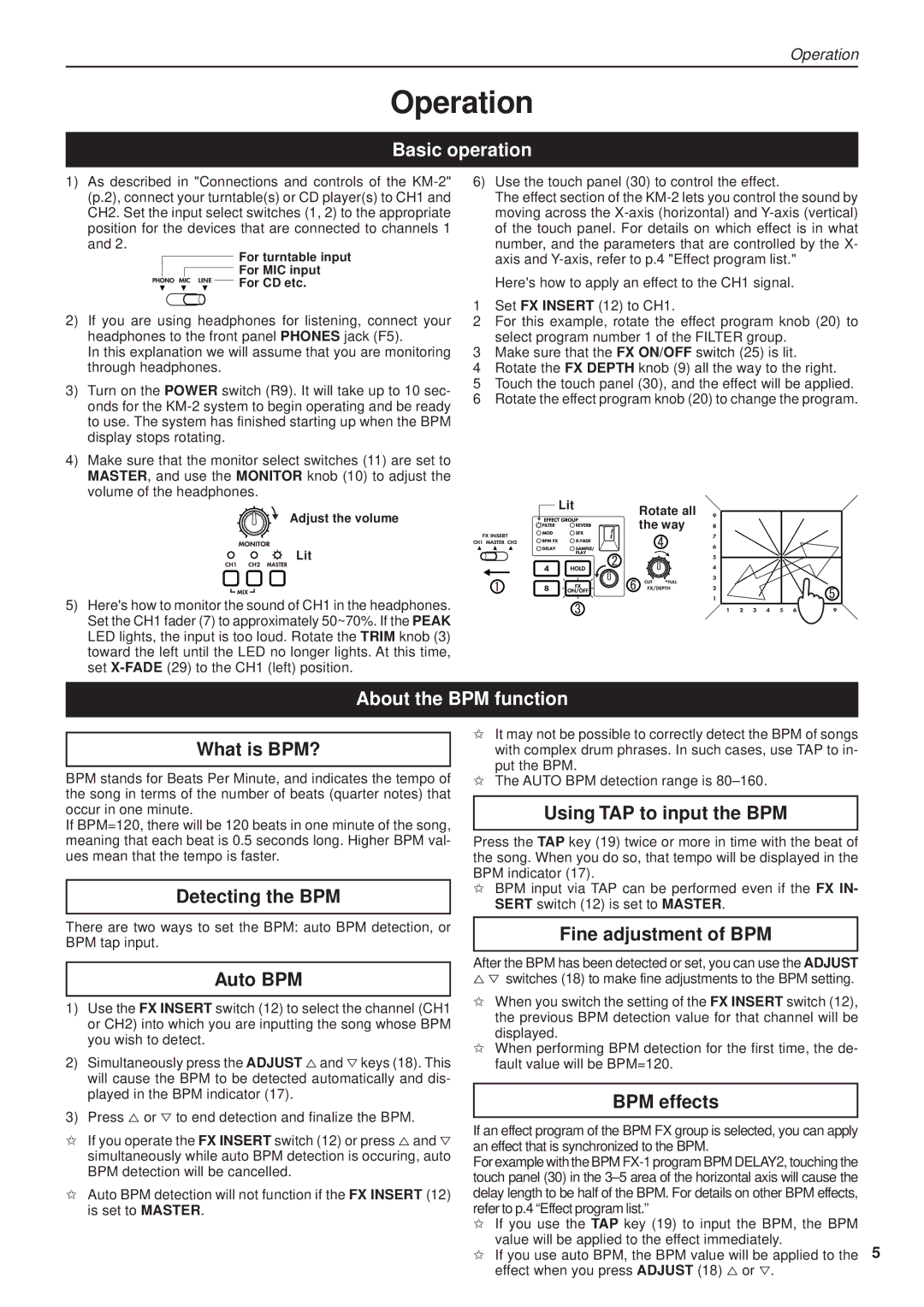
Operation
Operation
Basic operation
1)As described in "Connections and controls of the
and 2.
For turntable input
For MIC input
For CD etc.
2)If you are using headphones for listening, connect your headphones to the front panel PHONES jack (F5).
In this explanation we will assume that you are monitoring through headphones.
3)Turn on the POWER switch (R9). It will take up to 10 sec- onds for the
4)Make sure that the monitor select switches (11) are set to MASTER, and use the MONITOR knob (10) to adjust the volume of the headphones.
Adjust the volume
Lit
5)Here's how to monitor the sound of CH1 in the headphones. Set the CH1 fader (7) to approximately 50~70%. If the PEAK LED lights, the input is too loud. Rotate the TRIM knob (3) toward the left until the LED no longer lights. At this time, set
6)Use the touch panel (30) to control the effect.
The effect section of the
Here's how to apply an effect to the CH1 signal.
1Set FX INSERT (12) to CH1.
2For this example, rotate the effect program knob (20) to select program number 1 of the FILTER group.
3Make sure that the FX ON/OFF switch (25) is lit.
4Rotate the FX DEPTH knob (9) all the way to the right.
5Touch the touch panel (30), and the effect will be applied.
6Rotate the effect program knob (20) to change the program.
Lit | Rotate all |
| the way |
About the BPM function
What is BPM?
BPM stands for Beats Per Minute, and indicates the tempo of the song in terms of the number of beats (quarter notes) that occur in one minute.
If BPM=120, there will be 120 beats in one minute of the song, meaning that each beat is 0.5 seconds long. Higher BPM val- ues mean that the tempo is faster.
Detecting the BPM
There are two ways to set the BPM: auto BPM detection, or BPM tap input.
Auto BPM
1)Use the FX INSERT switch (12) to select the channel (CH1 or CH2) into which you are inputting the song whose BPM you wish to detect.
2)Simultaneously press the ADJUST %and Þkeys (18). This will cause the BPM to be detected automatically and dis- played in the BPM indicator (17).
3)Press % or Þ to end detection and finalize the BPM.
✩If you operate the FX INSERT switch (12) or press %and Þ simultaneously while auto BPM detection is occuring, auto BPM detection will be cancelled.
✩Auto BPM detection will not function if the FX INSERT (12) is set to MASTER.
✩It may not be possible to correctly detect the BPM of songs with complex drum phrases. In such cases, use TAP to in- put the BPM.
✩The AUTO BPM detection range is
Using TAP to input the BPM
Press the TAP key (19) twice or more in time with the beat of the song. When you do so, that tempo will be displayed in the BPM indicator (17).
✩BPM input via TAP can be performed even if the FX IN- SERT switch (12) is set to MASTER.
Fine adjustment of BPM
After the BPM has been detected or set, you can use the ADJUST
%Þswitches (18) to make fine adjustments to the BPM setting.
✩When you switch the setting of the FX INSERT switch (12), the previous BPM detection value for that channel will be displayed.
✩When performing BPM detection for the first time, the de- fault value will be BPM=120.
BPM effects
If an effect program of the BPM FX group is selected, you can apply an effect that is synchronized to the BPM.
For example with the BPM
✩If you use the TAP key (19) to input the BPM, the BPM
value will be applied to the effect immediately.
✩ If you use auto BPM, the BPM value will be applied to the 5 effect when you press ADJUST (18) % or Þ.
